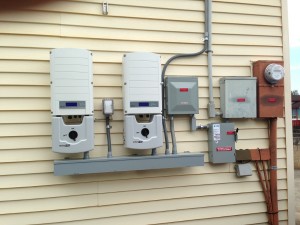Module-level power electronics — like power optimizers — have increased their influence in the industry in recent years.
By Mike Rogerson
According to Greentech Media, the module-level power electronics (MLPE) segment in 2009 was 51 MW. Today it stands close to 800 MW — an annual growth rate of around 150 percent. MLPE could be considered the next “killer app” of the U.S. solar market, but what is driving all of the attention? Initially, MLPE were regarded as niche products designed to reduce the impact of shading and to reduce losses on complex rooftops. They achieve this by eliminating what are known as mismatch losses. But today, MLPE are becoming a mainstream solution. The added energy was just the starting point. What attracts customers now is the design flexibility, module-level monitoring and enhanced electrical safety during installation and maintenance.

SolarEdge power optimizers are installed by Eco Solar on a rooftop in Hawaii. Module-level power electronics, like power optimizers, are growing in popularity. Photo courtesy of Eco Solar.
What are MLPE?
Module-level power electronics transfer some or all of an inverter’s functions to the module level. Basically, they are circuit boards that fit right next to the module in a PV array. The circuit boards serve as turbo boosters for the modules, enhancing energy output by maintaining the module at its maximum power point. Traditional inverters cannot do this because they only track the maximum power point for an entire string or array of modules. This means that when you connect modules in a string, you typically see 2 to 3 percent energy loss due to module mismatch. As modules age, these mismatch losses double, meaning that over the life of a PV system, the system owner loses around 5 percent of the energy of the PV array through mismatch. Shading can increase this up to 25 percent.
So, what makes MLPE the next “killer app” of solar? MLPE not only reduce the losses of a properly designed system but they can redefine proper design. Once there are electronics on the modules, system owners can do much more than module-level maximum power point (MPP) tracking. Since the modules operate independently, shading, module orientation and uneven string lengths are no longer design limitations. This allows designers the flexibility to cover more of the roof with solar and to cover the roof in new and novel ways. Module-level electronics can also enable improved safety features which automatically drop the string voltage to a safe voltage if the inverter is off. This creates a safer environment during installation, troubleshooting and in the event of an emergency.
Some MLPE solutions take this level of control one step further. For example, SolarEdge offers a module-level power optimizer with a fixed-voltage string inverter. The power optimizer performs module-level MPP tracking and DC/DC conversion to adjust the voltage and current on the output side of the power optimizer. This enables the inverter to work at a fixed voltage and eliminates MPP tracking and DC/DC conversion from the inverter. By controlling voltage at the module-level, an installer can see a significant increase in string sizing options. With traditional string inverters, string sizing is set by the MPP range of the inverter and by the module voltage. With SolarEdge power optimizers, since the voltage can be “bucked” lower or “boosted” higher, the maximum string length is determined by power and not by voltage. Since the MPP is handled at the module level, the requirement for inverter MPP is also eliminated. This enables an installer to use two to three times longer strings and to have a much wider range of string length options.

When coupled with a power optimizer, inverters can work at fixed voltages and eliminate MPP tracking and DC/DC conversion. Photo courtesy
of Eco Solar.
How MLPE Influence the Industry
Module-level electronics offer module-level monitoring that tracks output throughout the system life. The top companies in the MLPE space have millions of modules being monitored today, representing — arguably — the largest databases of module performance in the world. These solutions can create notifications (text messages and e-mails) for issues, saving O&M time and headcount throughout the lifetime of the system. Monitoring can also be used to further improve system design. Most designs today are built to maximize the first year of performance. But, the industry has very little understanding about maximizing lifetime performance in real world conditions, and this is one more area where MLPE can help. With MLPE, every installation becomes a miniature laboratory collecting performance data throughout the system life. Plus, the dataset grows with every system. The industry has just scratched the surface of what “big-data” will mean for solar.
With the growth in the MLPE market and the capabilities that are unlocked with this technology, MLPE is quickly approaching mass adoption. Enhanced energy production, simplified system designs, improved safety and visibility into module-level performance all offer significant changes to the industry. These changes will impact system designers, developers and owners, redefining what is proper and what is possible.
Mike Rogerson is marketing manager of North America for SolarEdge Technologies. Find more information at solaredge.com.
— Solar Builder magazine
[source: http://www.solarbuildermag.com/featured/solaredge-module-level-power-electronics/]
Leave a Reply
You must be logged in to post a comment.